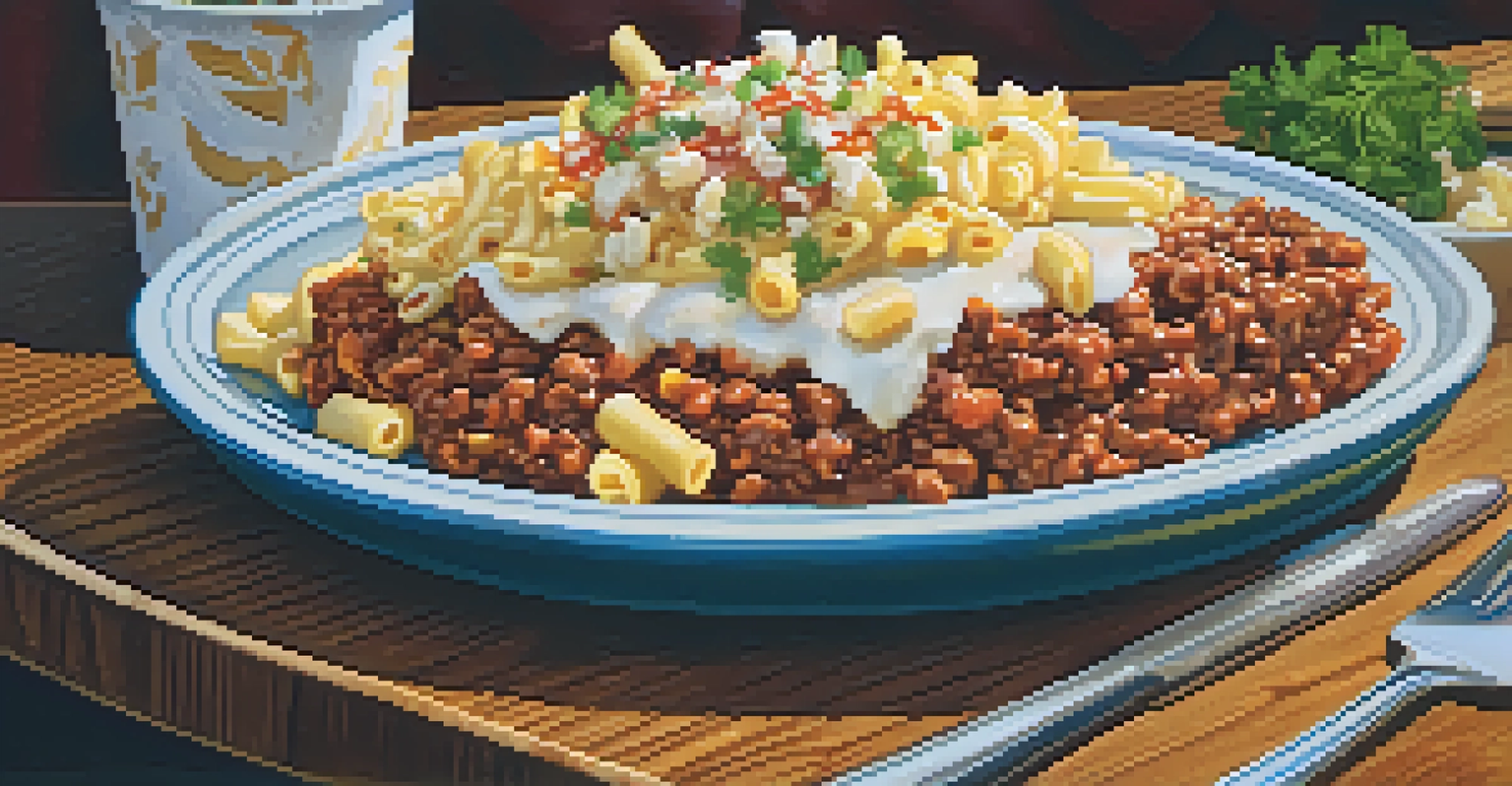A Taste of History: Traditional Dishes of Rochester Revealed

The Heritage of Rochester’s Culinary Scene
Rochester, New York, is a city steeped in history, and its culinary scene is no exception. The area's rich agricultural roots and diverse immigrant populations have shaped its unique food culture. This blend of traditions and ingredients has resulted in a variety of beloved dishes that tell the story of the city’s past.
Food is our common ground, a universal experience.
From the early settlers to the influx of immigrants in the 19th and 20th centuries, each group brought their flavors and techniques. These influences have melded over time, creating a distinctive Rochester palette that reflects both its history and community. When you dine here, you're not just tasting food; you're experiencing a piece of Rochester’s narrative.
Exploring Rochester’s traditional dishes is like reading a history book with every bite. Each meal offers a glimpse into the lives of those who have called this city home, making the culinary experience rich and meaningful. With that context, let’s dive into some of the standout dishes that define Rochester.
The Famous Garbage Plate: A Local Icon
One cannot mention Rochester’s culinary offerings without highlighting the infamous Garbage Plate. Created in the late 1900s, this dish is a heaping pile of comfort food that typically includes a mix of macaroni salad, home fries, and a choice of meats, all topped with a spicy meat sauce. It’s as messy as it sounds, but that’s part of its charm.

The Garbage Plate is more than just food; it’s a rite of passage for locals and visitors alike. Many college students swear by it after a night out, and it has become a symbol of Rochester’s late-night food culture. Eating a Garbage Plate means embracing the chaos and flavor of the city, often shared among friends in a laid-back atmosphere.
Rochester's Culinary Heritage Shines
The city's rich history and diverse immigrant influences have shaped a unique and meaningful food culture.
This dish encapsulates the spirit of Rochester: hearty, unpretentious, and unapologetically delicious. While some may raise an eyebrow at its name, it’s a source of pride for many. A visit to Rochester wouldn’t be complete without indulging in this local favorite.
Rochester Style Hot Dogs: A Unique Twist
Rochester’s hot dogs are another culinary delight that showcases local flavors. These aren’t your average hot dogs; they’re often served steamed or grilled and topped with a unique blend of mustard, onion, and a special meat sauce. This combination gives them a distinctive taste that sets them apart from hot dogs found elsewhere.
Cooking is like love. It should be entered into with abandon or not at all.
The tradition of Rochester-style hot dogs can be traced back to the early 1900s, when local vendors began experimenting with toppings. This creativity led to the iconic Rochester dog, which has become a staple at family gatherings, barbecues, and, of course, local eateries. Many residents have their preferred spots, each claiming to offer the best version.
When you bite into a Rochester-style hot dog, you’re experiencing a piece of the city’s history and culinary innovation. It’s a simple dish, yet it carries the weight of tradition and local pride, making it a must-try for anyone visiting the area.
The Sweet Side: Rochester’s Famous Pastries
Rochester has a sweet tooth, and its famous pastries reflect that passion. One of the most beloved treats is the iconic sponge candy, a light and airy confection that’s coated in rich chocolate. It’s a local favorite that brings back nostalgia for many residents, often enjoyed during special occasions or simply as a delightful indulgence.
Another standout is the Rochester-style cheesecake, known for its creamy texture and unique flavor. Unlike traditional cheesecakes, Rochester's version often incorporates a hint of lemon, giving it a refreshing twist. Local bakeries take great pride in their recipes, each claiming to have the best cheesecake in town.
Garbage Plate: A Local Tradition
The Garbage Plate is not just a dish but a cultural icon, representing Rochester's hearty comfort food scene.
These pastries are not just desserts; they are a connection to the community and its traditions. Sharing sponge candy or cheesecake with friends and family is a time-honored way to celebrate life’s moments, big or small. In Rochester, sweets are woven into the fabric of daily life, adding a sprinkle of joy to every meal.
Rochester’s Italian Heritage: A Culinary Influence
The Italian community has significantly influenced Rochester's culinary landscape, bringing with it delicious flavors and traditional recipes. From pasta dishes to classic sauces, Italian cuisine is deeply embedded in the local food culture. This heritage is celebrated through various restaurants and family-owned establishments that have been serving authentic Italian fare for generations.
One must-try Italian dish in Rochester is the classic chicken riggies, a hearty pasta dish featuring chicken, rigatoni, and a rich, spicy sauce. It’s a perfect example of how the city’s Italian roots have evolved, blending flavors that are both comforting and satisfying. Many families have their own variations, making it a dish that brings people together.
Rochester’s Italian influence showcases the city’s diversity and the power of food to connect cultures. Whether enjoying a plate of chicken riggies or a classic lasagna, you’re tasting the love and history that Italian families have poured into their kitchens. This legacy continues to thrive in Rochester, making it a vibrant part of the dining experience.
The Rise of Farm-to-Table: Freshness Matters
In recent years, Rochester has embraced the farm-to-table movement, which emphasizes fresh, locally sourced ingredients. This trend is a response to the growing demand for sustainable dining options and a desire to support local farmers. Many restaurants now feature menus that change seasonally, highlighting the best produce and meats available in the region.
By connecting diners with local farms, Rochester’s restaurants are not only serving delicious meals but also promoting community and environmental responsibility. Diners can enjoy dishes made with ingredients harvested just hours before, resulting in vibrant flavors and a deeper appreciation for the food on their plates. Concepts like this are bridging the gap between consumers and producers.
Embracing Farm-to-Table Freshness
Rochester's growing farm-to-table movement emphasizes local ingredients, enhancing the dining experience with seasonal flavors.
The farm-to-table movement is transforming Rochester’s dining scene, encouraging chefs to get creative with seasonal offerings. It’s a wonderful way to experience the city’s agricultural richness while enjoying a meal that reflects the essence of the region. As you explore Rochester, keeping an eye out for these fresh dining options will enhance your culinary journey.
The Role of Festivals in Celebrating Food
Rochester is home to several food festivals throughout the year, celebrating the city’s culinary diversity and rich traditions. These events are a fantastic opportunity for locals and visitors to come together and sample a variety of dishes from different cultures. From the Lilac Festival to the Rochester Italian Festival, there’s always something delicious happening in the city.
At these festivals, attendees can enjoy live music and entertainment while indulging in food from local vendors. It’s a vibrant atmosphere that fosters community spirit and showcases the culinary talents of Rochester’s residents. Whether it’s a plate of pasta or a slice of sponge candy, these events highlight the city’s gastronomic creativity.

Food festivals in Rochester are more than just eating; they’re a celebration of culture and heritage. They offer a chance to connect with neighbors, learn about different cuisines, and appreciate the city’s diverse food landscape. So, if you find yourself in Rochester during festival season, be sure to join in the fun and taste the flavors of the city.
Preserving Rochester’s Culinary Heritage
As Rochester continues to evolve, there is a growing awareness of the importance of preserving its culinary heritage. Many local chefs and food enthusiasts are dedicated to keeping traditional recipes alive while also embracing innovation. This balance ensures that the city’s food culture remains dynamic and true to its roots.
Community initiatives and workshops are popping up, encouraging younger generations to learn about traditional cooking methods and local ingredients. By passing down these skills, Rochester can maintain its rich culinary narrative while inspiring creativity in the kitchen. It’s a beautiful way to honor the past while looking toward the future.
In conclusion, Rochester’s food scene is a tapestry woven from history, culture, and community. Each dish tells a story, and each meal is a reminder of the city’s vibrant heritage. By savoring these traditional dishes, we not only enjoy delicious food but also participate in a shared experience that honors the flavors of Rochester.